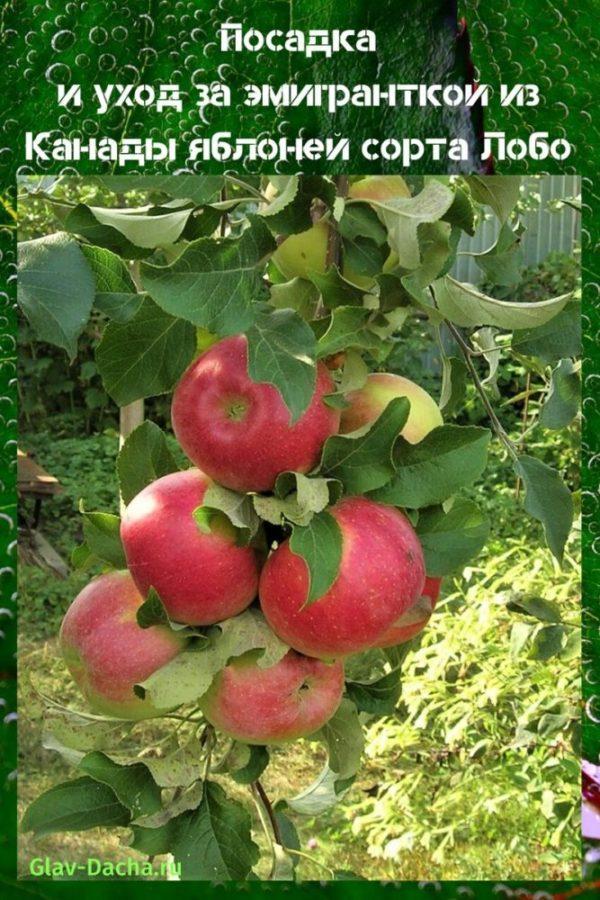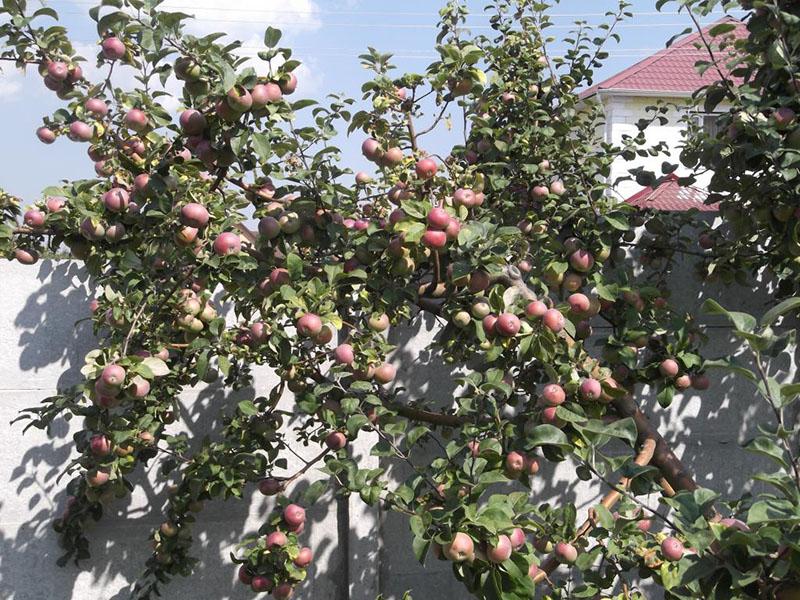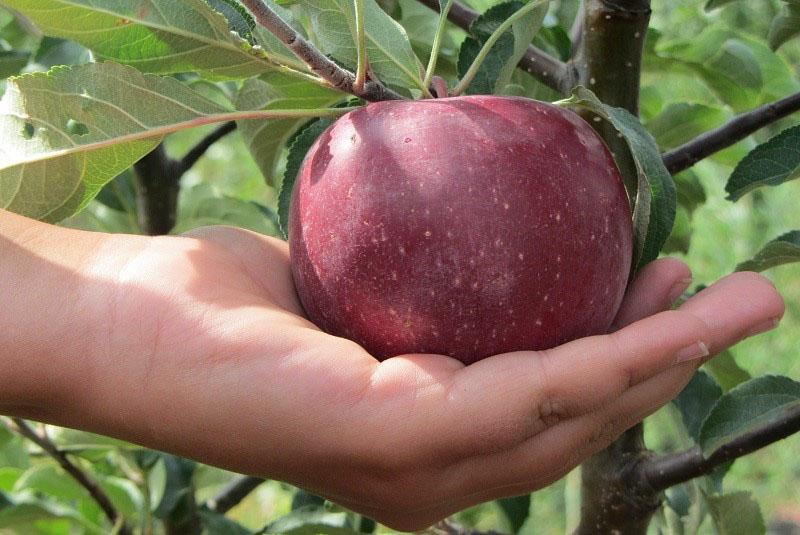Planting and caring for an emigrant from Canada with a Lobo apple tree
 An apple tree is a welcome guest at every summer cottage and garden plot. For years, gardeners have been choosing the best varieties for planting that would meet all the requirements. An emigrant from Canada has been pleasing for over 50 years with her unsurpassed taste and unpretentious care. Planting and caring for the Lobo apple tree will help you grow healthy fruit trees and get a good harvest.
An apple tree is a welcome guest at every summer cottage and garden plot. For years, gardeners have been choosing the best varieties for planting that would meet all the requirements. An emigrant from Canada has been pleasing for over 50 years with her unsurpassed taste and unpretentious care. Planting and caring for the Lobo apple tree will help you grow healthy fruit trees and get a good harvest.
The Lobo apple tree was bred in 1906 in Ottawa. The ancestor of the culture, from which it inherited excellent taste, is the Macintosh variety widely known in North America and New England. It was included in the State Register in 1972 and recommended for cultivation in the Central Black Earth Region.
Detailed description of the Lobo apple tree

It pleases with flowering in May, attracting attention with large, white, sometimes pink-tinted flowers.
The Lobo apple tree needs pollination, therefore it is recommended to plant varieties in the immediate vicinity: Spartak, Orlik, Green May.
The columnar apple "Lobo" begins to bear fruit in the 4th year of life. Ripe apples are different:
- round-conical shape;
- thin skin with a gray waxy bloom, painted in a raspberry color, which, when fully ripe, becomes maroon;
- deep, wide funnel;
- thin short stalk;
- white tender pulp of dense consistency with a rich caramel aroma;
- weighing up to 180 g.
 Tasters estimate the taste of the Lobo apple tree at 4.8 points.
Tasters estimate the taste of the Lobo apple tree at 4.8 points.
Pros and cons of the variety

The Lobo apple tree is endowed with a number of advantages, thanks to which it is in special demand among summer residents.:
- high and stable yields, up to 400 kg can be harvested from one tree.
- early maturity, the first harvest can be obtained for 3-4 years of growth;
- friendly ripening of apples, which shortens the harvesting period;
- excellent taste characteristics;
- frost resistance, the culture is able to withstand a temperature drop of up to 30 degrees;
- resistance to prolonged drought, not at the expense of the quality of the fruit;
- transportability without loss of taste and presentation.

The characteristic of the Lobo apple tree also includes disadvantages:
- tendency to fungal diseases: powdery mildew, scab;
- the need for props during fruiting, since the branches can break under the weight of the fruit;
- low self-fertility;
- insufficient heat resistance.
After grafting on another tree, it loses its early maturity and gives the first harvest only after 7 years.
Planting and caring for the Lobo apple tree
 To achieve a harvest of good quality healing fruits, all the requirements for planting, caring for the Lobo apple tree should be taken into account.
To achieve a harvest of good quality healing fruits, all the requirements for planting, caring for the Lobo apple tree should be taken into account.
Recommended timing
In regions with a warm climate, planting can be carried out in the fall, so that in the spring the seedling enters an active phase of development. The favorable period is the end of September.
In the northern regions, plan planting work in the spring. The root system will have time to get stronger and form before the onset of frost, and the shoot will store enough nutrients. The optimal time for the procedure is the end of April.
Selection of seedlings
 High-quality planting material is considered a determining factor when laying an apple orchard.
High-quality planting material is considered a determining factor when laying an apple orchard.
When choosing a seedling, it is worth considering:
- Vaccination trace. It is he who is considered the guarantee of the authenticity of the Lobo variety.
- Age. Give preference to 1-2 year old seedlings, at least 1 m high.
- The root system. It should be well developed with no rot symptoms, about 40 cm long.
- The appearance of the escape. Check for diaper rash and dry branches.
It is recommended to purchase seedlings from specialized nurseries or other proven places.
Choosing the right place

Criteria for choosing a successful place for active growth and development of an apple tree seedling of the Lobo variety:
- spacious, well-lit area;
- no draft and protection from strong winds;
- the depth of the groundwater is not less than 1.5 m;
- loamy or sandy loam soil.
The soil must be fertile. If necessary, it is important to apply the necessary complex of fertilizers in advance.
Planting technology of seedlings

For successful cultivation, it is required to correctly plant the Lobo apple tree, which consists of the following stages:
- Dig a hole: 70 cm deep and 80 cm wide.
- Connect 15 kg of the top layer of the earth with 15 kg manure, add 300 g of wood ash and fill the mixture with the same amount of superphosphate.
- Fill the hole 1/3 with prepared fertile soil, drive in a peg for reliable support.
- Lower the seedling into the hole, gently straightening its root system.
- Sprinkle with nutritious substrate, shaking slightly to fill the void between the roots.
- After installing the tree, tie it to a peg and water it.
For mass planting, keep a distance of 3 meters between trees and 2.5 meters between rows.
Watering mode
 The Lobo apple tree does not like abundant moisture due to its poor resistance to fungal diseases. Water a young plant once every 2 weeks, consuming 2 buckets of water, and an adult plant once every 4 months, using 40 liters of liquid.
The Lobo apple tree does not like abundant moisture due to its poor resistance to fungal diseases. Water a young plant once every 2 weeks, consuming 2 buckets of water, and an adult plant once every 4 months, using 40 liters of liquid.
After each moistening, loosen the soil of the trunk circle to prevent the occurrence of mold and increase the access of oxygen to the root system.
Seasonal fertilizers
 Despite its modesty in needs, the Lobo apple tree will thank you for feeding with a good harvest.
Despite its modesty in needs, the Lobo apple tree will thank you for feeding with a good harvest.
The main thing is to apply fertilizers in a timely manner:
- From mid-March to the second decade of April, before bud break, add 600 g of urea, stepping back 25 cm from the trunk.
- After flowering, saturate the plant with organic fertilizer. Dissolve 2 kg of bird droppings in a bucket of water. Each tree needs 2 buckets of solution.
- The first days of September should be accompanied by mineral feeding. Combine 10 liters of water, 500 g of nitroammofoska and 10 g of sodium humate. For one tree, 3 buckets of nutrient are enough.
- In the last decade of October, to have time to add 30 liters of a solution of 30 g of potassium, 60 g of superphosphate and 10 liters of water under each apple tree.
Neglecting fertilization can cause stunted tree growth or reduced hearth quality.
Mulching and pruning

Mulching protects the roots of apple trees from freezing in the winter and from overheating in the summer. Perform the procedure after planting, and repeat every year.
Apply needles, cones, sawdust, straw or cut grass as mulch.
 The formation of the crown should be started from the first year after planting. To prolong the fruiting period, carry out regular formative pruning.
The formation of the crown should be started from the first year after planting. To prolong the fruiting period, carry out regular formative pruning.
Preparing for winter

Preparation for prolonged frost is accompanied by the following actions:
- dispose of fallen leaves, fruits from the site and burn;
- whitewash the trunk to neutralize pests and destroy fungal spores;
- water it well, loosen and mulch the soil with sawdust;
- carry out sanitary pruning of dry, damaged branches;
- wrap the trunk in the lower part with roofing felt to protect the bark from rodents.
Be especially careful when preparing apple trees for winter if they grow in the northern regions.
Treatment against diseases and pests
According to the description of the Lobo apple tree, the culture is characterized by low immunity to diseases, especially sensitive to scab, powdery mildew. To prevent the plant from being infected with pathogenic microorganisms, you need to process them using folk remedies or fungicides.
Pests are no less dangerous for the tree: moth, silkworm, hawthorn, miner moth, fruit sapwood. Fight parasites by treating trees with insecticides.
Harvesting and storage of crops
 Harvesting starts in the last days of September and lasts about a week. Collect fruits in dry weather, without removing the stalk and without wiping off the natural wax coating.
Harvesting starts in the last days of September and lasts about a week. Collect fruits in dry weather, without removing the stalk and without wiping off the natural wax coating.
Store the crop in a dark and dry room with a temperature ranging from +3 to +7 degrees. In such conditions, apples will lie for 3-4 months.
Planting and caring for the Lobo apple tree is within the power of even an inexperienced gardener. Performing all the techniques of agricultural technology, you can find an approach to this fruit crop. And she, feeling cared for, will begin to actively grow, develop, yielding tasty, healthy fruits.